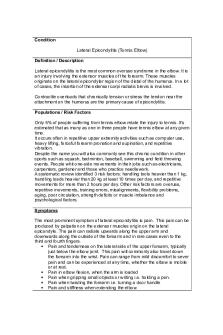Adhesive Capsulitis - clinical pattern sheet PDF

| Title | Adhesive Capsulitis - clinical pattern sheet |
|---|---|
| Course | Essentials of Musculoskeletal Physiotherapy |
| Institution | University of the West of England |
| Pages | 3 |
| File Size | 99.9 KB |
| File Type | |
| Total Downloads | 35 |
| Total Views | 193 |
Summary
clinical pattern sheet...
Description
Condition Adhesive Capsulitis
Definition / Description Adhesive Capsulitis, also known as Frozen Shoulder Syndrome (FSS) is a condition that leads to pain, stiffness and loss of ROM in the shoulder. The disease affects the anteriosuperior joint capsule, axillary recess and the coracohumeral ligament.
Populations / Risk Factors It's estimated that up to 1 in 20 people in the UK may be affected by frozen shoulder at some point in their life. More prevalent in woman, individuals aged 40-65 years old and people who suffer from diabetes. Occurrence rate of 25% in the general population. More chance of having adhesive capsulitis bilaterally. Other associated risk factor includes; Trauma Prolonged immobilization Thyroid disease Stroke Myocardial infarcts Presence of autoimmune disease Symptoms Patients presenting with Adhesive Capsulitis will report a progressive increase in pain, and a gradual decrease in active and passive ROM. It is considered to be a self-limiting disease, with patients frequently having difficulty with grooming, overhead activities and dressing. Reports suggest that symptoms may never fully subside. Literature reports that Adhesive Capsulitis progresses through three overlapping clinical phases; Acute/freezing/painful phase: Gradual onset of shoulder pain at rest with sharp pain at extremes of motion, and pain at night with sleep interruption which may last anywhere from 3-9 months. Adhesive/frozen/stiffening phase: Pain starts to subside, progressive loss of glenohumeral motion in capsular pattern. Pain is apparent only at extremes of movement. This phase may occur at around 4 months and last until about 12 months. Resolution/thawing phase: Spontaneous, progressive improvement in functional range of motion which can last anywhere from 1 to 3.5 years.
Clinical Signs
Observation of posture and positioning – scapular winging of the involved shoulder may be viewable from the posterior or lateral views. Upper Quarter Exam (UQE) and neuro screen (dermatomes, myotomes and reflexes) – to rule out cervical spine involvement or any neurological pathologies ROM – Active/passive and overpressure of cervical and thoracic spine, shoulder and rib mobility. Muscle strength testing – shoulder external/internal rotation and seated abduction. Joint accessory mobility of glenohumeral joint. Special test to include hand-to-neck (shoulder flex, abduction & external rotation), hand-to-scapula (shoulder ext, adduction and internal rotation), hand-to-opposite scapula (shoulder flex and horizontal adduction).
History Adhesive Capsulitis can be classed as primary or secondary. It is considered primary if the onset of pain is idiopathic whilst secondary results from a known cause or surgical event. Three sub categories of secondary frozen shoulder include; Systemic (diabetes and other metabolic conditions) Extrinsic (cardiopulmonary disease, humerus factures, Parkinson’s disease) Intrinsic (rotator cuff pathologies, tendonitis, AC joint arthritis) Investigations X rays are usually only needed if the presentation is atypical or the patient is not responding to treatment. Blood tests and radiography should only be performed if red flag symptoms are present. Atypical Presentations
Osteoarthritis (OA) Bursitis Parsonage-Turner Syndrome (PTS) Rotator Cuff (RC) Pathologies Posterior Dislocation
Management Options and Levels of Evidence A holistic approach to treatment should be used, considering psychological and psychosocial factors.
Treatment should begin with paracetamol and NSAIDS, moving onto the use of a TENS machine. Joint mobilisation combined with stretching exercises to improve ROM Passive mobilisation and capsular stretching are two of the most commonly used techniques for physiotherapy. Corticosteroid injections can be used in the early stages of the condition to reduce any signs of inflammation. Distension therapy involves injecting large volumes of fluid (saline or local anaesthetic) into the shoulder joint, with the aim of distending or even rupturing the joint capsule. Surgical treatment may be in the form of manipulation under anaesthesia (MUA), which involves passively moving the arm to tear the thickened inflamed coracohumeral and glenohumeral ligaments as well as stretch the capsule. Management of frozen shoulder varies amongst surgeons. Therapists should encourage early activity.
Useful Resources http://www.physio-pedia.com/Adhesive_Capsulitis http://www.nhs.uk/Conditions/Frozen-shoulder/Pages/Introduction.aspx...
Similar Free PDFs

Clinical Pattern sheet
- 10 Pages

Medial meniscus clinical pattern
- 3 Pages

COPD - clinical pattern sheets
- 2 Pages

Clinical brain sheet
- 1 Pages

ABC Tile Adhesive Quick Guide
- 1 Pages

Pattern Comportamentali
- 23 Pages
Popular Institutions
- Tinajero National High School - Annex
- Politeknik Caltex Riau
- Yokohama City University
- SGT University
- University of Al-Qadisiyah
- Divine Word College of Vigan
- Techniek College Rotterdam
- Universidade de Santiago
- Universiti Teknologi MARA Cawangan Johor Kampus Pasir Gudang
- Poltekkes Kemenkes Yogyakarta
- Baguio City National High School
- Colegio san marcos
- preparatoria uno
- Centro de Bachillerato Tecnológico Industrial y de Servicios No. 107
- Dalian Maritime University
- Quang Trung Secondary School
- Colegio Tecnológico en Informática
- Corporación Regional de Educación Superior
- Grupo CEDVA
- Dar Al Uloom University
- Centro de Estudios Preuniversitarios de la Universidad Nacional de Ingeniería
- 上智大学
- Aakash International School, Nuna Majara
- San Felipe Neri Catholic School
- Kang Chiao International School - New Taipei City
- Misamis Occidental National High School
- Institución Educativa Escuela Normal Juan Ladrilleros
- Kolehiyo ng Pantukan
- Batanes State College
- Instituto Continental
- Sekolah Menengah Kejuruan Kesehatan Kaltara (Tarakan)
- Colegio de La Inmaculada Concepcion - Cebu









